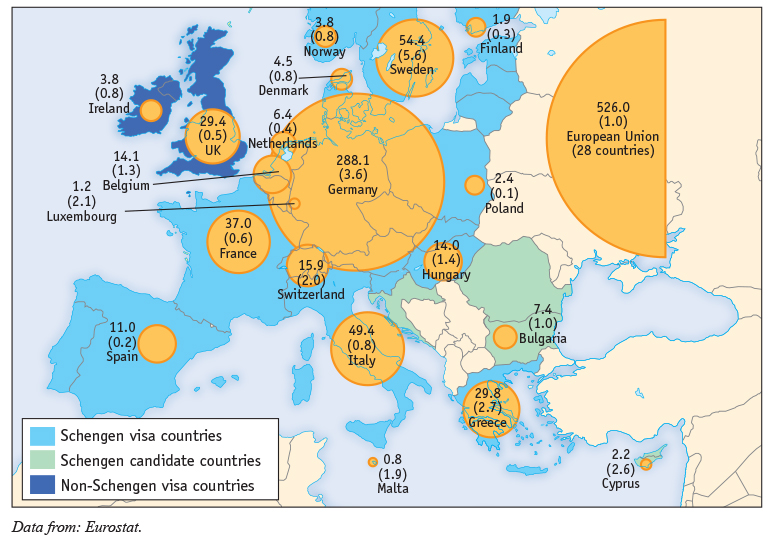Chapter 5. Brussels Resumes Policy Push to Share Out Refugees
Discussion Questions
Chapter 5 HEADLINE: Brussels Resumes Policy Push to Share Out Refugees Across EU
During 2015, millions of immigrants from the Middle East and Africa who were seeking asylum entered the European Union, creating a crisis as the European countries were overwhelmed with the inflow, some more than others. This article discusses the sources and destinations of the migrants, and the challenges faced by the European governments. In March, 2016, new regulations were announced by the European Commission, eliminating rules that made the first country where refugees enter responsible for their asylum claim.

The graph is plotted with the following approximate data presented in the format (country - number of pending applications): Syria - 60; Afghanistan - 39; Kosovo - 32; Pakistan - 29; Eritrea - 25; Serbia - 24; Albania - 23; Iraq - 21; Nigeria - 20; Russia - 19; Somalia - 15; Ukraine - 13; Bangladesh - 12; Macedonia - 11; Iran - 10.
The European Commission will launch a fresh attempt to share out asylum seekers across the EU after a summer surge of migrants seeking to cross into Europe. Under the proposals, which will be released by the end of the year, refugees will be shared out automatically whenever a country faces a sudden influx of migrants. The move is likely to upset some member states—particularly in eastern Europe—who roundly rejected a similar plan to share out automatically 40,000 asylum seekers landing in Greece and Italy during a summit that degenerated into a late-night slanging match between national leaders.
The renewed policy move comes after Germany said this week that it would receive 800,000 asylum applications this year, and gave warning that the EU’s asylum rules must be reformed or the border-free Schengen Area would face collapse. Almost all of these arrivals come via other EU countries—something that EU rules, which require that asylum seekers must be processed in the first member state in which they arrive, are meant to prevent. With no border checks within the Schengen Area, however, it is nigh on impossible to keep asylum seekers in one country.

Data is as plotted in the map as follows, presented in the format (Number of pending applications for asylum (in thousands) - Number of pending applications per 1000 in the population):
Application for asylum in Schengen visa countries: Spain (11.0 - 0.2); France (37.0 - 0.6); Switzerland (15.9 - 2.0); Italy (49.4 - 0.8); Hungary (14.0 - 1.4); Sweden (54.4 - 5.6); Denmark (4.5 - 0.8); Norway (3.8 - 0.8); Belgium (14.1 - 1.3); Luxembourg (1.2 - 2.1); Netherlands (6.4 - 0.4); Finland (1.9 - 0.3); Poland (2.4 - 0.1); Greece (29.8 - 2.7); Malta (0.8 - 1.9).
Application for asylum in Schengen Candidate countries: Bulgaria (7.4 - 1.0); Cyprus (2.2 - 2.6).
Applications for asylum in Non Schengen visa countries: UK (29.4 - 0.5); Ireland (3.8 - 0.8).
European Union (28 countries) (526.0 - 1.0)
Text below the map reads, “Applications for Asylum, 2015: The first number shown for each country is the number of pending asylum applications, in thousands, as of May 2015. The second number (in parentheses) is the pending asylum applications per 1,000 in the population.
(Source: Excerpted from Duncan Robinson and Jeevan Vasagar, “Brussels Resumes Policy Push to Share out Refugees across EU,” Financial Times, August 21, 2015, p. 3.)”
With some countries such as Germany receiving far more applications than their neighbours, calls for tighter border controls—even within the border-free Schengen bloc—have grown. Thomas de Maizière, Germany’s interior minister, said this week: “Control-free borders cannot exist in the long term without a real European asylum policy.” …. . The Social Democrats, junior partners in the ruling coalition, favour an immigration law that would create a clear legal avenue for entry to Germany from outside the EU. However, Chancellor Angela Merkel’s conservative bloc is divided over the need for new migration legislation.
Source: Excerpted from Duncan Robinson and Jeevan Vasagar, “Brussels Resumes Policy Push to Share out Refugees across EU,” Financial Times, August 21, 2015, p. 3.
Question 1
Question
Based on the discussion within the chapter, why might Germany and Eastern European countries have conflicting views on immigration?
65FRbtvWhl4=Question 2
Question
What would be a possible benefit of “sharing” surges of immigrants, as opposed to processing immigrants in the first member state they arrive in?
65FRbtvWhl4=Question 3
Question
Why might the Social Democrats favor an immigration law that eases entry in Germany from outside the EU? Why might the conservative bloc be divided or opposed?
65FRbtvWhl4=Question 4
Question
What would be the likely short- and long-run effect on wages and returns to capital from maintaining open internal borders of the Schengen Area, as the sharing of refugees would likely maintain?
65FRbtvWhl4=